|
By now, just about everybody has heard about the many benefits of trees in the urban landscape. They fight climate change by storing carbon in the soil; cool and clean the air; provide critical wildlife habitat—and these are just a few of the ways trees help cities like Concord. Valuing our trees is not a new thing in this town. For the last 42 years, Concord has been named a Tree City USA by the National Arbor Day Foundation. Unfortunately, over the past several years, many mature trees have been lost due to extreme weather. Weakened by years of drought, many have fallen during severe winter storms or simply died of thirst. Of course, it’s important to replace them with young trees without delay. It’s also critically important to care for the mature trees that remain. If you own property with trees, you can contribute a lot to our community by caring for them properly and making sure they are pruned correctly. In pruning mature shade trees, the number one mistake to avoid is the practice called “topping”—that is, indiscriminately cutting branches to reduce the overall size of the tree. (Pruning fruit trees is a different matter entirely; learn how to do that here.) What’s so bad about topping? According to Craig N. Huegel in his wonderful book The Nature of Plants, trees and other plants have something called an apical meristem--apical meaning “of the apex” and meristem meaning the cells that are capable of producing new cells. Young plants’ growth centers on this area. As plants grow, they develop meristematic tissue at the tips of branches as well as the main stem. When a branch is lopped off (pruned or chomped), the area just below the damage starts acting like an apical meristem. That’s why pruning a shrub makes it bushier. But trees shouldn’t be pruned like shrubs. They need to have one main trunk. When multiple branches are hacked off, the tree no longer knows where its apical meristem is. It is confused. To quote Huegel, ”'Topping' produces long-term damage to a tree as it forces the tree to continuously reconfigure its growth. Instead of a strong main trunk, multiple weaker trunks are formed and the tree will be forever perplexed as to where it should allocate its resources. The trunk below will grow normally, but the area above will never do so.” Topping stresses a tree in other ways as well. Removing too many leaves reduces its food supply; exposing its bark to too much sun and heat damages the tissues underneath; and leaving open wounds at branch ends makes the tree vulnerable to insect and disease infestations. Topping can even kill a tree. To find out more, click here. The Sacramento Tree Foundation’s website has detailed information on pruning techniques. They include step-by-step instructions for pruning a young tree—but recommend that mature trees be pruned only by a certified arborist. Although an arborist will charge more than a landscaper with a chain saw, their expertise will preserve the tree’s health and beauty—and enhance your property’s value. In some cases, when big trees are too close to power lines or buildings, there’s no way to prune them properly. The best course of action may be to remove the tree and replace it with a different species that’s more appropriate for the location. If you own property, consider planting trees where possible, and be sure to choose the right kind of tree for the space. Native species are often ideal because they support the local ecosystem and generally need less maintenance. If you have mature trees, please care for them and help them thrive. In this time of climate crisis, every living tree is precious. -Friends of Concord Creeks Friends of San Ramon Creek Co-Chair Recognized for Exemplary Leadership in Watershed Conservation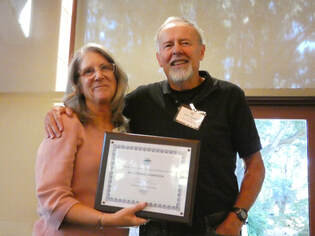 Danville, CA — At the 2023 Contra Costa County Creek and Watershed Symposium, a well-deserved spotlight shone on Dick Heron, Co-Chair of the Friends of San Ramon Creek, who was honored with the prestigious Watershed Champion Award. The accolade pays tribute to individuals who have demonstrated remarkable dedication, leadership, and partnership-building in the protection, restoration, and enhancement of local creeks and watersheds. Heron's contributions to the Friends of San Ramon Creek have been nothing short of extraordinary. With unwavering enthusiasm and dedication, he has been instrumental in leading various efforts within the group, furthering the cause of preserving San Ramon Creek and its watershed. Among his significant contributions, Heron has organized presentations as part of the Danville Library speaker series, spreading awareness about the importance of watershed health. He has also played a pivotal role in the group's water quality monitoring program, which is vital for understanding and preserving the local environment. However, one of the most outstanding and ongoing initiatives spearheaded by Dick Heron is the eradication of the invasive weed, Arundo donax, from the San Ramon Creek subwatershed. Recognizing the magnitude of the task at hand, Heron took the initiative in 2013, leading volunteer groups in removing Arundo from several areas along the creek in Danville. What sets Dick Heron apart is his forward-thinking approach. He collaborated with a software expert to develop a comprehensive map, meticulously tracking the locations of Arundo within the subwatershed. This strategic move laid the foundation for a highly organized and effective eradication effort. Through the challenges posed by each passing year, Dick Heron and the dedicated volunteers of Friends of San Ramon Creek have honed their removal methods to maximize efficiency. They meet every Friday from April through October, tirelessly working to remove Arundo from the creek banks. Thanks to Heron's strong leadership, the Friends of San Ramon Creek have successfully eradicated a remarkable 120,000 square feet of the known 160,000 square feet of Arundo in the San Ramon Creek subwatershed. Heron's dedication goes beyond the hands-on work. He ensures the volunteer team is equipped with all necessary permits, landowner permissions, and the required equipment for their weekly efforts. Furthermore, he keeps regulatory agencies well-informed about the progress of the eradication effort. The impact of Dick Heron's work extends far beyond the removal of invasive species. His leadership has served as a source of inspiration, motivating people to collaborate towards healthier watersheds in Contra Costa County. The recognition and honor bestowed upon him as the 2023 Watershed Champion reaffirms the tremendous value of his contributions. In response to the award, Heron expressed his gratitude and emphasized the importance of collective efforts in preserving the region's watersheds. He continues to serve as an inspiration to residents of Danville and beyond, reminding us all of the difference one person can make in the pursuit of a healthier and more sustainable environment. Congratulations, Dick Heron! The idea of urban rewilding is catching on all over the world. Green spaces are sprouting up everywhere—in pocket parks, on rooftops, along busy roads—as more and more of us understand the need to restore all kinds of ecosystems, including the ones within our cities.
Restoring forests is especially important. We need mature, functioning forests to draw down carbon, cool the air, restore habitat for wildlife—and for many other reasons. But when left to the process of natural succession, forests can take 150 to 200 years to reach maturity. Fortunately, thanks to the work of Dr. Akira Miyawaki, mature, native-like forests can be created on degraded land in just 30 to 50 years. Dr. Miyawaki’s innovation, essentially, was to plant native canopy species very densely, along with other, smaller native species. A Miyawaki mini-forest can be as small as six parking spaces—or much bigger. Weeding and watering are needed only for the first few years. In the last twenty years, mini-forests planted with the Miyawaki method have sprouted across the globe, including the UK, Europe, and Canada. Mini-forests are growing in Western Australia, which, like California, has suffered the climate challenges of heat, drought, and wildfire. Pocket Forests WA, a Perth-based nonprofit, has started new mini-forests in schoolyards, where children learn about Nature by planting and tending the young trees. Their website offers this brief explanation of Dr. Miyawaki’s methods. In the US, mini-forests are just catching on across the country, from a park on a former landfill in Cambridge, MA, to a vineyard on California’s central coast. In suburban Tucson, AZ, the Rose Community Forest will create a haven for wildlife and a peaceful place for people to enjoy Nature. Seattle’s South Park Forest is sited amid low-income communities in an industrialized, polluted part of the city. The mini-forest there will heal the land and make the air more breathable. And mini-forests offer other benefits: for example, they can be a screen protecting a community from freeway noise or an unsightly view—and they can provide cooling shade to combat the heat-island effect in neighborhoods that don’t have enough trees. A book by Hannah Lewis, Mini-Forest Revolution: Using the Miyawaki Method to Rapidly Rewild the World, is an invaluable tool for anyone wishing to create a mini-forest. It provides not only a detailed description of the method, but also many case studies of projects in a wide variety of environments. One chapter is a field guide covering the essential steps:
Miyawaki-style mini-forests have been planted in five Berkeley schoolyards, but Contra Costa has yet to plant its first one. That needs to change. The City of Concord, like many US cities and towns, is moving to plant hundreds of trees in parks and along streets. But a forest is much, much more than a group of trees, and a native-like mini-forest offers many more ecological benefits compared to trees planted in isolation. We aim to work with the City of Concord to plant a Miyawaki mini-forest on public land. To restore our watershed and ensure a livable future for Concord, the time for planting is now. But to make it happen, your help is needed! To learn more, please shoot an email to [email protected]. -Friends of Concord Creeks Do you enjoy San Ramon Creek? Want to learn more about the creek & how you can help protect it?
The Friends of San Ramon Creek is hosting an informational meeting in Danville on Wednesday, June 15 at 5:30 pm in the Mt. Diablo Room of the Danville Public Library. The meeting is for everyone with an interest in our local creeks and who want to get involved in keeping them healthy. The featured speaker is Malcolm Sproul, who will provide tips about creek stewardship and flora, especially plants that stabilize, enhance the creeks and provide important habitat. He’ll also share stories about observed changes in our creek system over the decades and the biggest threats to a healthy watershed at this time. Malcolm received his B.A. and M.L.S. in Environmental Planning, from UC Berkeley, and then worked for the Marin County Planning Dept. for four years. In 1979, he joined LSA Associates and is now a principal in natural resources management and environmental planning, managing their Point Richmond office. An avid outdoorsman, Malcolm serves on the board of Save Mount Diablo and lives with his wife Casey live in Moraga. In 2020, Malcolm received Save Mount Diablo’s Mountain Saver Award and Diablo Magazine’s Threads of Hope Award. The Friends of San Ramon Creek is a grassroots organization whose mission is to support programs and projects which promote a healthy San Ramon Creek. Come learn about your local creek and get involved! For more information contact: Elizabeth Harvey Roberts [email protected] At the March 1st Board of Supervisors virtual meeting, the Supervisors unanimously signed a proclamation recognizing the Friends of San Ramon Creek, Walnut Creek Watershed Council, Contra Costa Fish and Wildlife Committee, and the volunteers.
Two of the hardworking volunteers, Mike Anciaux of Alamo and Dick Heron, a Danville resident, pictured here left to right with Supervisor Andersen, were instrumental in removing Arundo, an invasive non-native plant that consumes prodigious amounts of water, spreads aggressively, is a fire hazard, provides little in the way of habitat for animals, and can restrict creek flow. Dick and Mike were able to stop by Supervisor Andersen's Danville office and accept the proclamation in person. 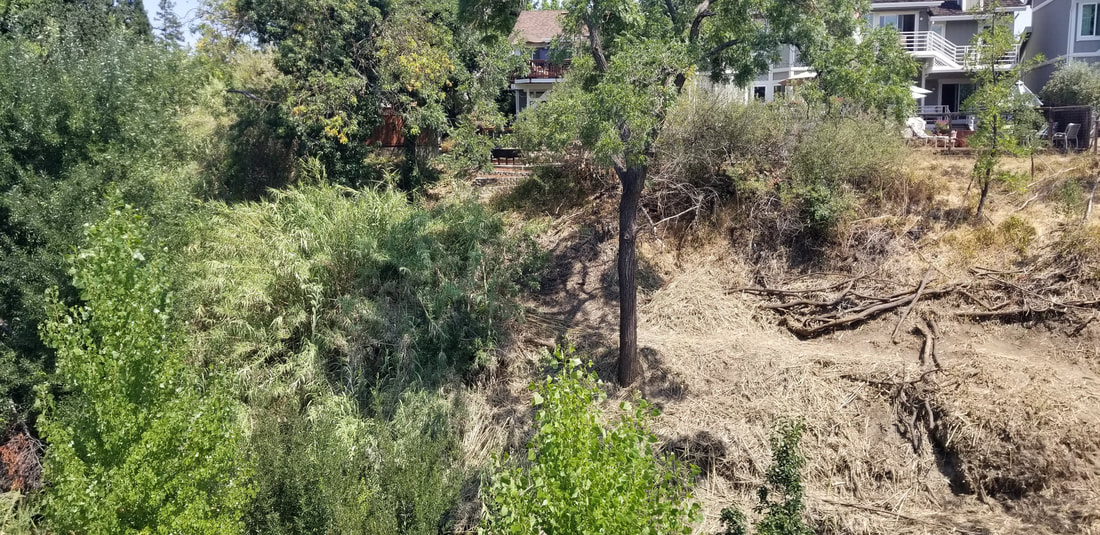 A record 30,000 sf of Arundo was removed from the San Ramon Creek subwatershed. This was almost double the amount removed in the previous year. There is approximately 82,000 sf of Arundo identified but not yet removed or treated. Eradication of Arundo in this subwatershed is a real possibility in the next 5 years. We removed and treated the Arundo in 16 sites primarily in four locations in Danville and Alamo. We gave priority in removal to those patches located furthest upstream including a very large and highly visible site located across from Front St in downtown Danville. The work was done by a combination of a small team (5 to 10) of volunteers who worked one or two days each week, three large community group events, two contractors and several homeowners. We continue to inspect and treat all of the sites that we have treated since 2013. The initial treatment seems to kill around 90% of the Arundo. Each month for several years we see some small regrowth that we treat immediately. We are thankful for donations and grants from the Walnut Creek Watershed Council, Republic Services, and the Contra Costa County Fish and Wildlife Propagation Fund. 2021 Arundo Removal - by the Numbers FSRC had outstanding success at removing Arundo from the San Ramon Creek Watershed this year. We doubled the amount of Arundo removed in 2020. In 2021 we removed 30,000 sf of Arundo or about 20% of the total Arundo mapped along San Ramon Creek. It is almost twice as much as last year. At this rate we certainly should be able to do an initial treatment of just about all of the Arundo in our sub-watershed in 5 years. This is an amazing accomplishment for a task that seemed endless just a short time ago! Note however that the actual amount of Arundo remaining will probably exceed the listed 82,000 sf. As we look closely at patches we are finding that there are some additional patches and many of the patches have grown significantly since the original mapping. We used a variety of sources of manpower to remove the Arundo. We are very thankful to the funding provided by the Walnut Creek Watershed Council that allowed us to hire contractors. We are making some headway on getting homeowners to remove their own Arundo. But most of all we appreciate our volunteers who removed about 2/3 of the Arundo this year. What a great team they have been all year. It has been a joy to work with all of them!
Use a Contractor to Remove Your Arundo and FSRC Will Pay HalfIf you own land along the San Ramon Creek you may be one of the 74 properties known to have Arundo growing on your property, Friends of San Ramon Creek (FSRC) would like to help you eradicate this noxious weed from your property. FSRC is offering to share the cost of removal of your Arundo when you use a contractor to remove your Arundo and treat it with herbicide to keep it from coming back. You can use either a contractor that FSRC recommends or, if you have a contractor who can do it cheaper, then your own contractor. FSRC will pay 50% of the invoice after the removal and treatment. FSRC has limited funds, so this offer is good until this year's allotment of funds is exhausted. Arundo Is Invading our Creek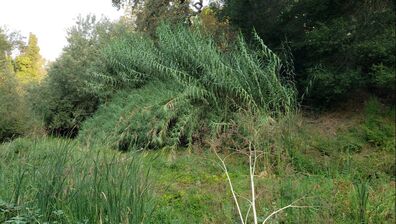 Arundo Crowds Out Everything Else Arundo Crowds Out Everything Else Arundo (Arundo donax) is a non-native invasive plant with stems that resemble bamboo and leaves that resemble corn. Also called "giant reed" or "giant cane," Arundo is a fast-growing plant that can grow four inches a day and up to thirty feet tall. To sustain its rapid growth, Arundo consumes prodigious amounts of water, usually along streams and other waterways. It outcompetes native plants and provides little food or habitat for insects, birds, or other wildlife. 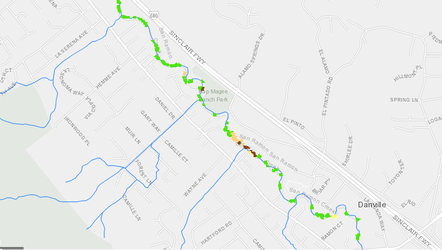 74 Stands of Arundo in San Ramon Creek 74 Stands of Arundo in San Ramon Creek Arundo is taking over sections of the San Ramon Creek between Danville and Alamo. To date, Friends of San Ramon Creek (FRSC) has mapped 131 stands covering approximately 118,000 sq. ft. in the San Ramon Creek watershed. Over the last 7 years FSRC has treated 35 of these patches. There remain 96 patches covering 87,000 sf on 74 different parcels, almost all on private properties. If we don’t stop it, the banks of the creek will be monoculture Arundo and will have much less biodiversity, more fire danger, less water, and more erosion caused by creek narrowing and diversion. Removing Arundo Is Hard Work But It Can Be Successful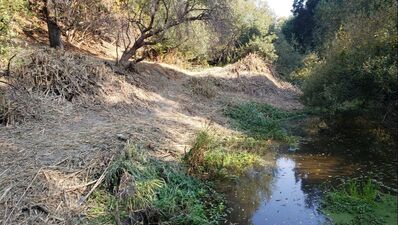 Arundo is typically eradicated by cutting the stalks and hauling them away and immediately treating the stumps with an herbicide to prevent regrowth. Arundo will have some regrowth after this treatment and will require monthly retreatment for several years to kill all of the plant. FSRC has been removing patches of Arundo for 7 years and has refined techniques that make this arduous job as simple as possible. 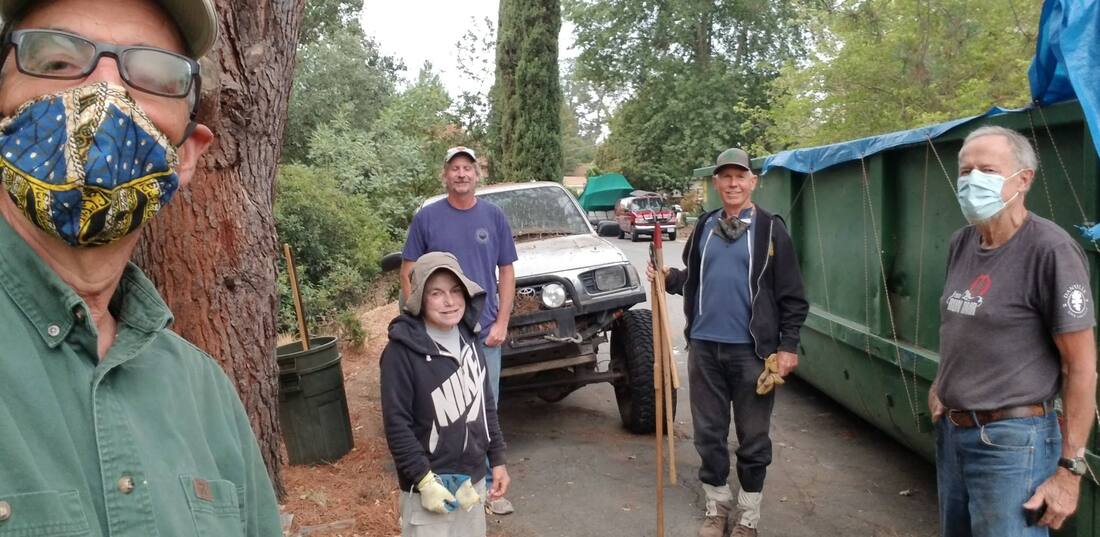 Each Thursday morning, for the last seven weeks, a group of four to six Friends of San Ramon Creek (FSRC) volunteers met in the Whitegate/Cameo area of Danville to remove four stands of Arundo from the Green Valley Creek watershed. Two of the four stands were quite large and very dense. It was hard work but the Arundo has been removed, the rhizomes treated with an herbicide and the rhizome area covered with a geotextile to kill the rhizomes by solarizing (baking) them. There are over 100 stands of Arundo in the San Ramon Creek subwatershed; most of them are on private property. FSRC is working to develop ways to work with property owners to remove these stands. This particular group of stands was chosen because iit provided an opportunity to test an approach to working with property owners and their neighbors and because is one of the furthest upstream stands. Working With Private Property Owners The project started with visits by a volunteer to get permission from the property owners to remove the Arundo. In this case, there were four properties with Arundo; one owned by a Homeowners Association and three owned by homeowners. One of the volunteers met with each of the property owners and explained the issue with Arundo in the creek and described the process to remove it. It took several visits with each property owner to get agreement to the plan for removal, treatment and maintenance. The volunteer then visited with all surrounding property owners to let them know what was happening so they were not surprised. One of the homeowners was insistent that we not use glyphosate. Small Group of Workers Can Socially Distance On July 31 the volunteers started attacking the stands one by one. With these large stands it was possible to keep five or six volunteers working and still stay socially distant. In each case a chain saw was used to quickly cut the stalks. The stalks were moved out of the way and piled into large, orderly, piles nearby. We tried not to use bucket brigades to move the canes but depended on a contractor to haul large piles up the hill and to the dumpster. De-duffing Needed To Treat Stumps When the stalks from a stand had been removed the team went back and de-duffed the stand. The volunteers used small rakes and hands to remove the leaves, dead stalks and other material that covered the ground between the stumps. The goal was to see the ground between the stalks. This effort was significant. It took about ⅓ of the time that it took to remove the stalks just to de-duff it. The duff was piled up near the stand and left to compost in place. Treated Stumps With Weedslayer After de-duffing, the stumps were recut with a chainsaw as close to the ground as practical. Then a volunteer painted each of the cut stumps with a highly concentrated herbicide (50% water, 50% Weedslayer or Roundup custom). Weedslayer Seems To Work On Stumps 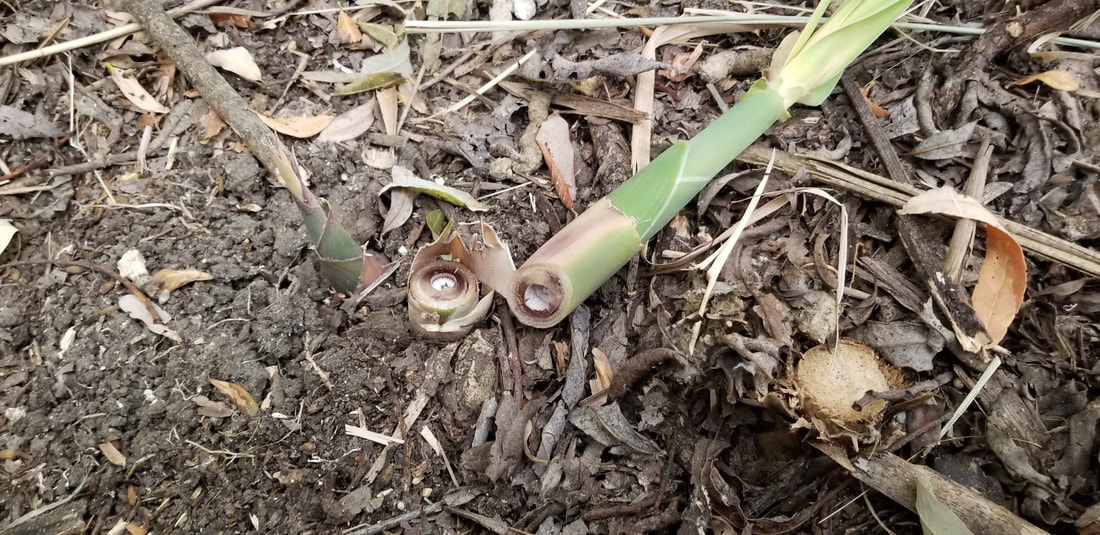 Since the stands were treated over a period of six weeks or so and with different herbicides we were able to see the different impact of the herbicides.
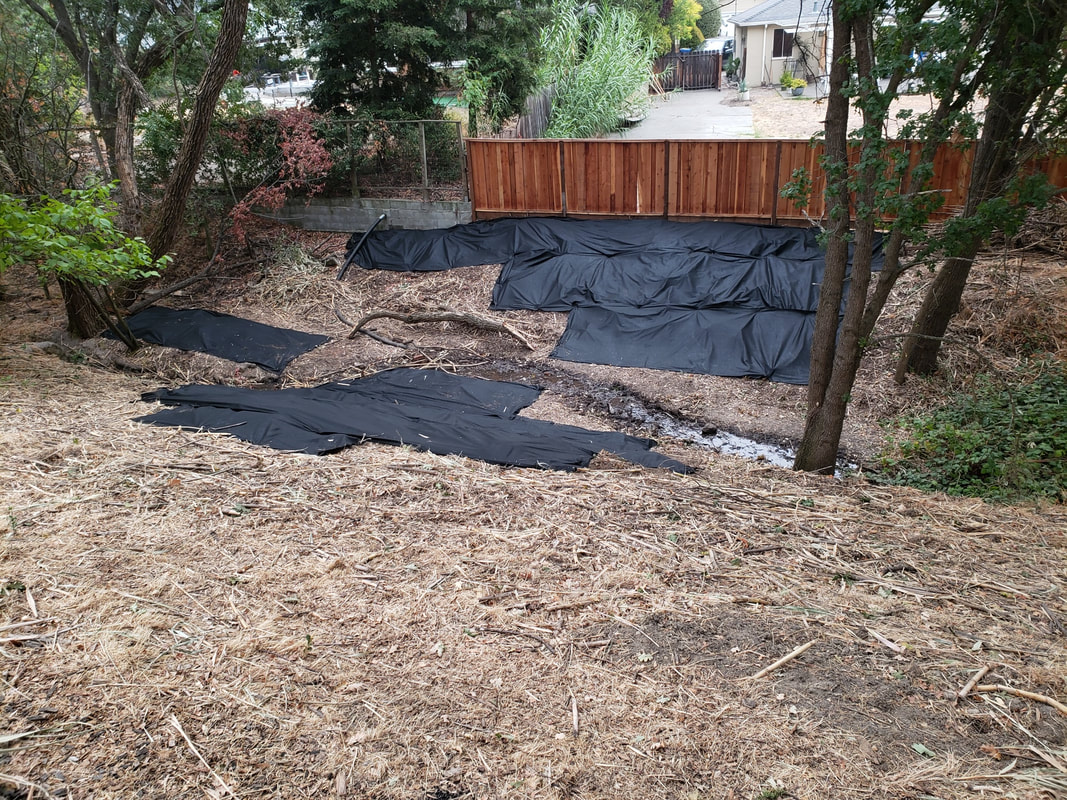 The final part of the treatment was another experiment by FSRC. A geotextile material was cut and laid over the exposed rhizomes and was attached to the ground with long staples. It is hoped that the black material will absorb heat and kill the rhizomes. We are unsure if this technique will work, how long it will take and whether aggressive growth will damage the geotextile. We anticipate leaving the geotextile in place for a year to maximize the effect. Contractor Hauled Stalks and Chipped Into Dumpster 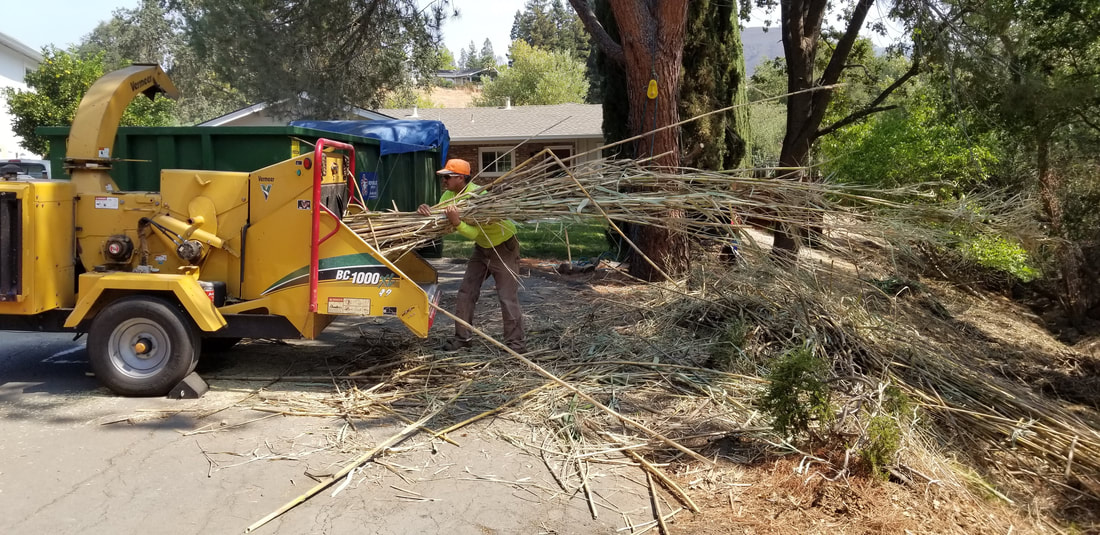 The piles of stalks were huge, maybe six feet around. They would have filled several dumpsters if we had put them in unchipped. In order to minimize the number of dumpsters required FSRC hired a contractor to haul the stalks to a dumpster and chip them into the dumpster. This seemed to reduce the volume needed to be hauled by ¾ or more. The contractor was able to save a lot of labor by dragging the bundles from the staging area near the stand to the dumpster. A rope was cinched around the bundle of stalks; the other end of the rope was tied to a truck and the truck pulled the pile up next to the chipper. For more information about this Arundo removal project contact Mike Anciaux at [email protected]. There are over 110 patches of Arundo in the San Ramon Creek Watershed. In 2019 Friends of San Ramon Creek started treating about 10 of the patches and hope to work on another 10 or more in 2020. We are in the process of selecting the candidates for 2020 efforts using the following criteria
Help restore Lafayette Creek by planting CA native plants!
Join The Restoration Trust, Lafayette Creeks Committee, and the Contra Costa Resource Conservation District for a CA native planting event in Lafayette! We will be planting native plant plugs along the northern bank of Lafayette Creek in the western part of Downtown. Revegetating the creek with native plants makes it more difficult for non-native invasive plants to establish themselves, and it provides habitat and food for wildlife. For this event, we are limiting registration to 30 volunteers, so sign up ASAP. We hope you'll join us! This event will take place rain or shine, but may be delayed a bit during heavy rain. Date: Sunday, January 12, 2020 Time: 9:30 AM - 11:30 AM Location: Adjacent to 3725 Mt. Diablo Blvd., Lafayette, CA 94549 (See the map in the flyer below.) More Important Details:
|
Walnut Creek Watershed Council
|
Copyright 2024 Walnut Creek Watershed Council. All Rights Reserved.
Many images courtesy of the Contra Costa Resource Conservation District. |



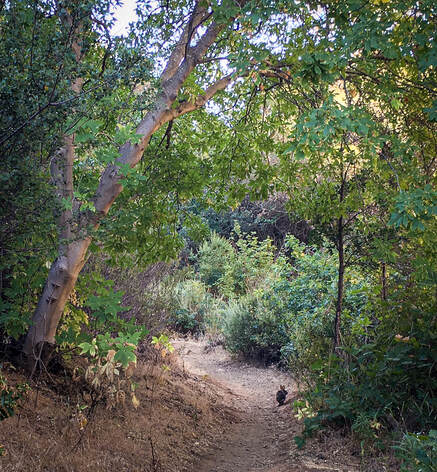
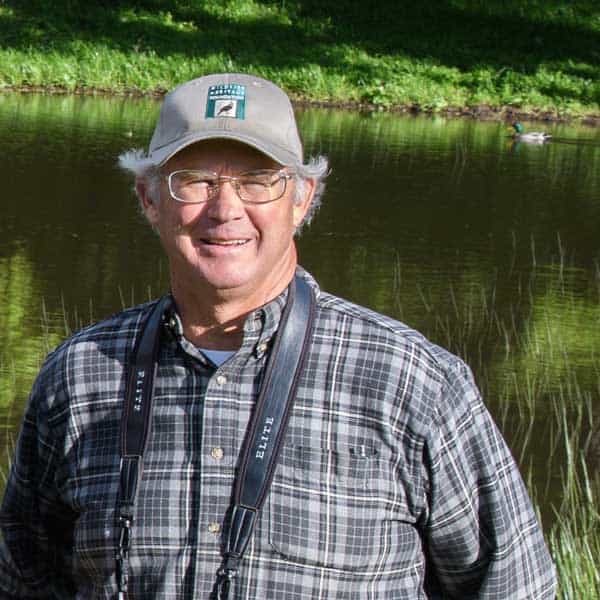
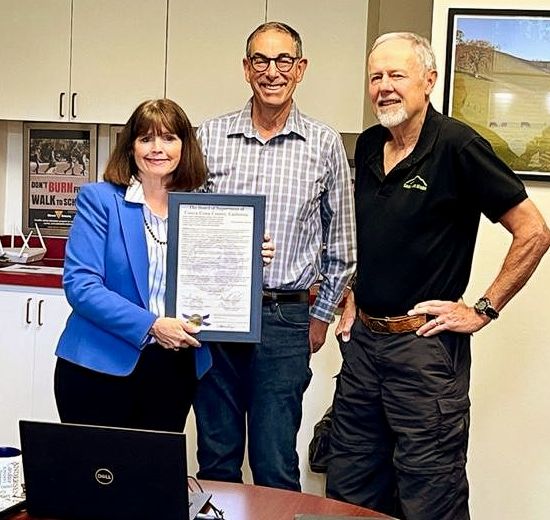
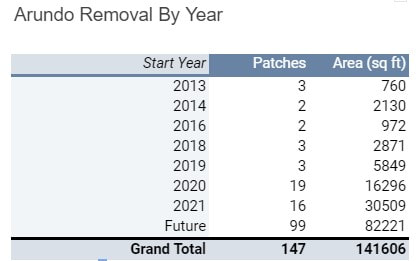
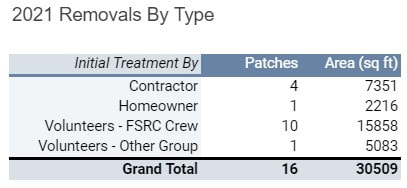
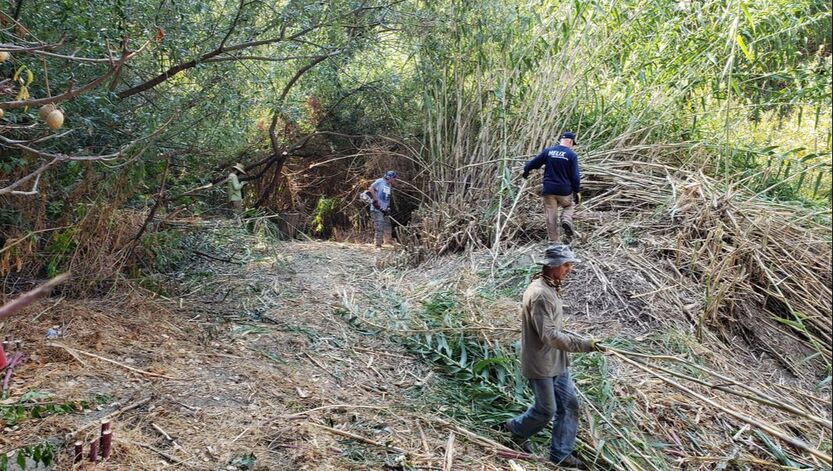
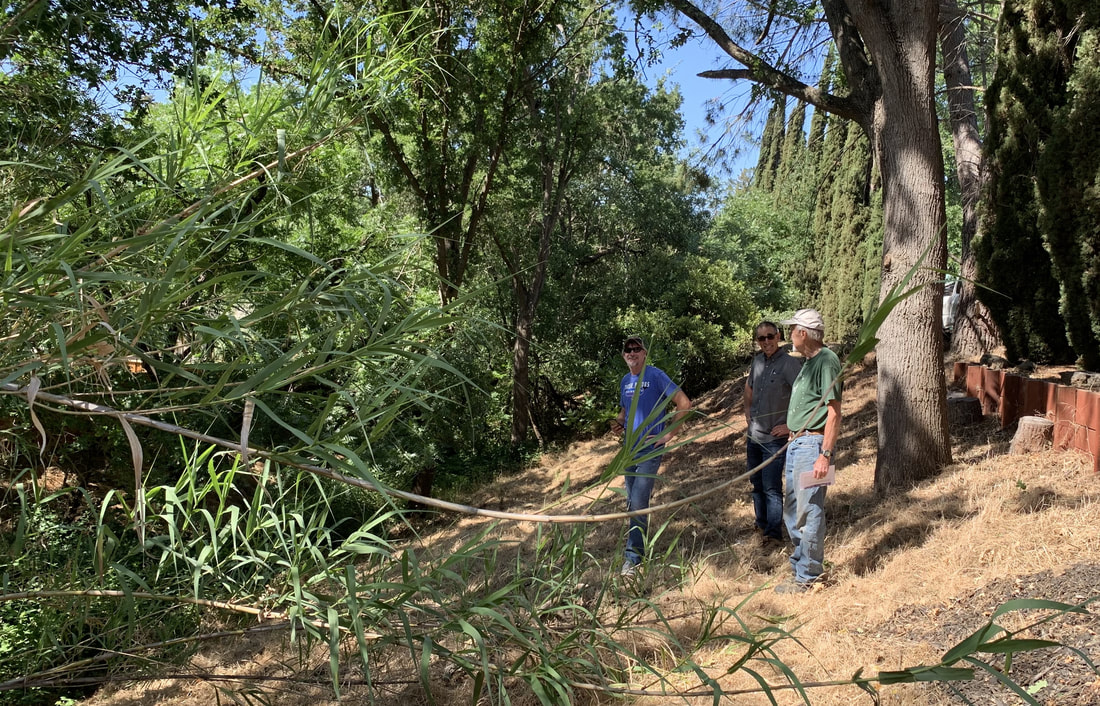
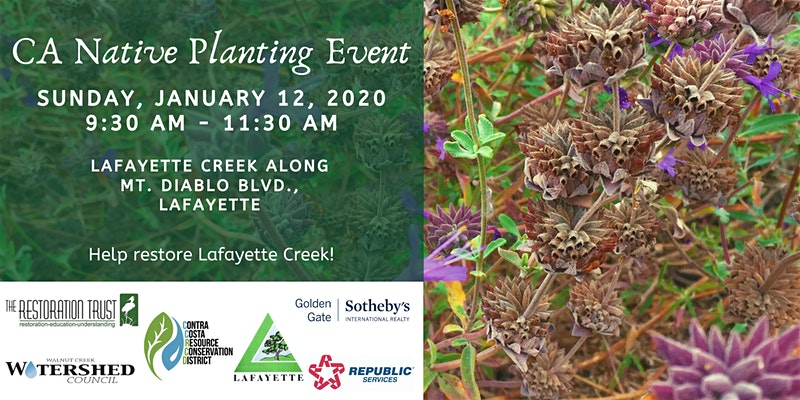
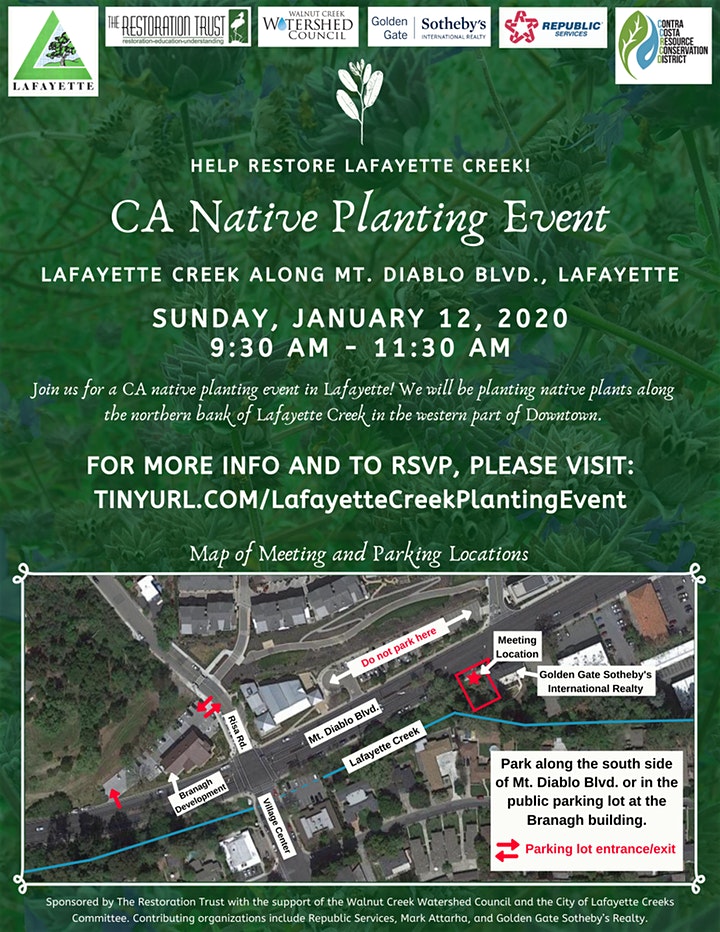
 RSS Feed
RSS Feed